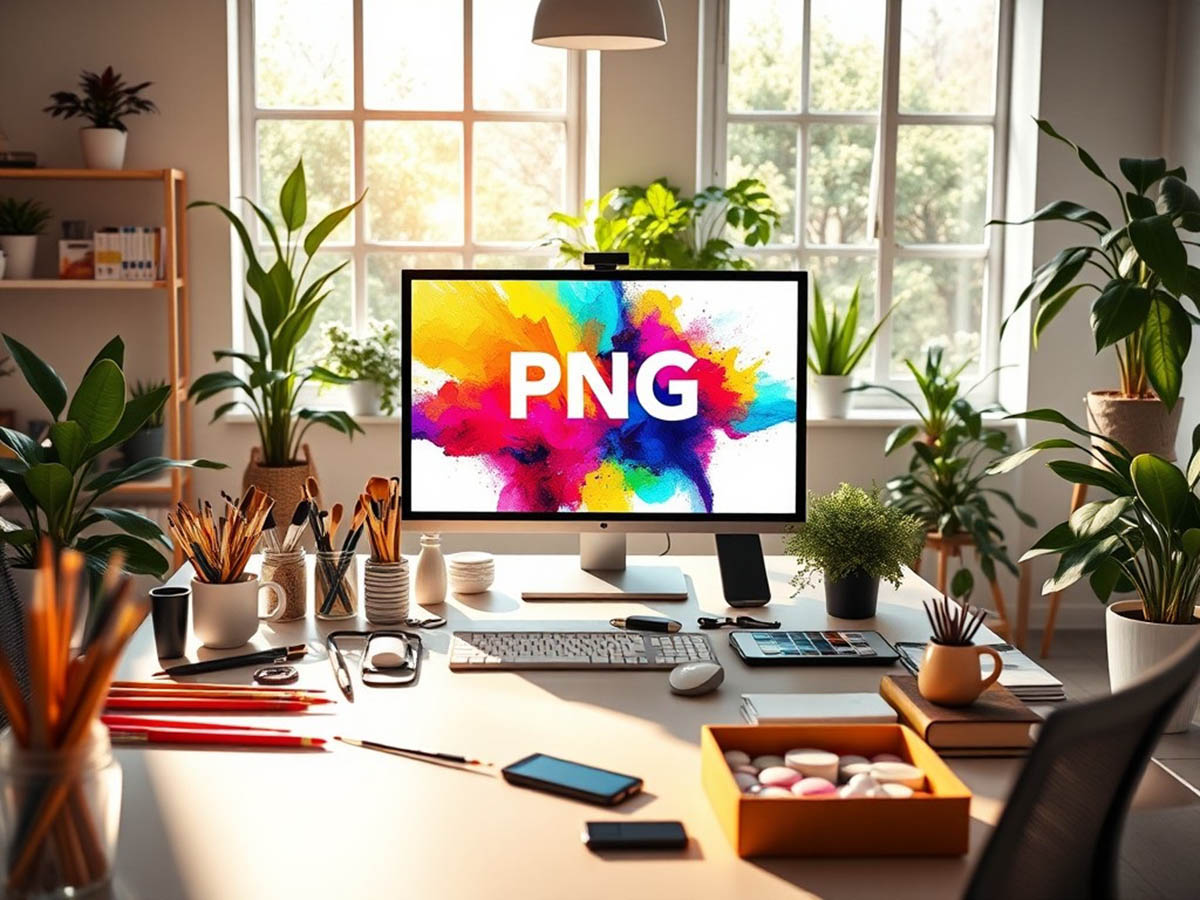Using clear, precise imagery plays a pivotal role in captivating an audience. High-resolution PNG images offer unmatched clarity, which serves as a backbone for compelling visual material. This page explains how these file types support superior image quality while detailing best practices, real-life examples, and actionable insights for crafting engaging visuals.
The Advantages of Using PNG for Visual Content
PNG images provide transparency, maintain crisp detail, and support a wide range of colors, making them an ideal choice for visual materials. Designers appreciate these files for their reliability and consistency. Their lossless compression ensures no data is sacrificed, so images remain sharp even after multiple edits. This file type is especially useful for graphics that require a transparent background, seamlessly integrating with varied design layers.
Technical benefits aside, PNG images improve readability and message clarity when paired with supporting text or data visualizations. Their ability to preserve fine details means visual content appears cleaner and more professional, giving viewers a sense of reliability and trust in the information presented.
Best Practices for Integrating PNG Images
Optimizing PNG Images for Web Use
When incorporating these images, optimization becomes essential. Files must balance quality and loading speed, as a heavy file can slow page performance. Techniques include compressing images without compromising visible quality and choosing the correct dimensions to fit the layout. Users should employ modern editing tools to reduce unnecessary metadata and improve load times, ensuring the site remains both visually striking and responsive.
Effective optimization often involves testing various settings to determine the best balance between image clarity and page performance. Visual consistency across devices is paramount, so designers often create multiple versions for desktops, tablets, and smartphones. This approach helps maintain a uniform visual presentation regardless of the device used to view the content.
Maintaining Consistent Visual Style
A consistent visual style contributes to a unified look throughout a project. Choosing a coherent color scheme and adhering to preset design standards help form a recognizable identity. Designers work to align the imagery with overall content themes, ensuring that every graphic reinforces the site’s core message. Consistency extends beyond color; it also involves style, tone, and layout, which ultimately improve user experience and engagement.
Using high-quality images consistently also builds trust among viewers. A clean, coordinated visual approach shows attention to detail and professionalism. Efforts to harmonize visuals can involve regular audits of graphic assets and close collaboration with creative teams to enforce guidelines across all projects.
Real-World Applications of High-Quality PNG Images
Various sectors benefit from the clarity and precision of PNG images. Marketing campaigns, data presentations, and social media graphics all rely on high-quality visuals to communicate ideas effectively. For example, infographics require clear, crisp visuals that translate complex data into easily digestible formats. Designers use these images to illustrate trends, compare statistics, and highlight key points in a manner that words alone cannot.
In digital interfaces, the use of rich visual iconography helps create intuitive layouts and guides user behavior. Icons, charts, and diagrams rendered as PNG files can define a user’s journey, making digital interactions smoother and more engaging. Real-world case studies from various industries have shown that well-integrated images increase both time spent on pages and overall satisfaction with the experience.
This approach has influenced modern design trends, with many creative professionals incorporating high-resolution visuals to distinguish their work. The clarity provided by these images supports both practical and aesthetic functions, ensuring that visuals convey messages quickly and efficiently.
Enhancing Content Engagement with High-Quality Visuals
A well-executed visual strategy transforms basic content into an interactive experience. High-resolution imagery draws attention and aids in breaking up text-heavy sections. Visuals support narrative flow and encourage readers to absorb information at a deeper level. Studies have shown that well-crafted images result in improved retention and increased interaction rates.
The role of clear visuals extends beyond mere decoration. They serve as visual anchors, guiding readers through content that might otherwise seem dense or technical. Engaging images foster an inviting atmosphere, reducing reader fatigue and encouraging exploration. By integrating thoughtfully chosen graphics, content creators can ensure that their audience remains interested and informed.
In digital publications, even subtle improvements in visual quality can make a significant difference. Incorporating high-quality PNG images contributes to a cleaner, more professional presentation, setting a tone that resonates with a discerning audience. This thoughtful approach to image selection and placement strengthens overall communication efforts and supports the narrative in a memorable way.
Recommended Tools for PNG Image Creation and Editing
Many software options cater to designers aiming to produce flawless visuals. Free and paid tools both offer robust features for creating, editing, and optimizing PNG files. Programs that support layer management and transparency controls are especially valuable. Users benefit from experimenting with various applications to determine which best meets their workflow and quality requirements.
Modern image editors now provide features that automatically adjust file properties for faster loading without sacrificing clarity. These tools help maintain a balance between aesthetics and performance, ensuring images appear sharp on all devices. Creative professionals often opt for tools that offer batch processing capabilities, saving time and standardizing image quality across projects.
Additional applications focus on intuitive interfaces and real-time editing previews. Such features enable creators to fine-tune every pixel, making adjustments visible instantly. Software options with plug-in support further extend functionality, allowing users to incorporate specialized filters and effects. Mobile solutions also exist that cater to on-the-go edits without compromising the essential characteristics of PNG files. These versatile programs offer flexibility that suits both beginners and experienced designers.
Case Studies and Success Stories
Numerous brands have achieved noticeable success by integrating high-resolution PNG images into their visual strategy. One example features a marketing campaign that used clear, precise visuals to explain complex product benefits. The campaign recorded a surge in user engagement and a positive shift in brand perception. Another instance involves a data-driven website that used detailed graphics to clarify statistical trends, thereby boosting audience trust and retention.
Real-world examples extend to educational platforms that use PNG files to illustrate intricate concepts through layered diagrams and annotated images. Creative teams have reported that maintaining a consistent, high-quality image format contributed to better communication and streamlined workflow among departments. In some cases, organizations noticed a marked improvement in page load times and user satisfaction after switching to optimized PNG assets. These instances further underscore the importance of selecting the right file format to support sophisticated visual narratives.
Each success story reiterates that investment in superior visuals often leads to tangible benefits. Users who prioritize high-resolution graphics observe increased dwell time and higher conversion rates. A blend of artistic insight and technical know-how, demonstrated in these scenarios, encourages content creators to adopt innovative strategies and adopt tools that maximize visual impact.
Final Thoughts on Leveraging PNG for Visual Excellence
High-quality visual content relies on clear, precise imagery that effectively communicates its intended message. PNG images offer a reliable solution, ensuring that graphics remain sharp and free of unwanted distortions. Their transparency, robust color support, and lossless nature make them a strong asset in any digital design arsenal.
Every creative project gains from the use of consistent, optimized visuals. When designers focus on maintaining style uniformity and integrating relevant graphics into their narrative, content transforms into an engaging experience. High-quality imagery not only improves user interaction but also builds a visual language that reinforces trust and professionalism.
The benefits of using these resources extend to various content types, including charts, icons, and detailed diagrams. Each element works together to produce a refined, coherent presentation. By following best practices and utilizing effective editing tools, content creators can maximize the potential of these images, resulting in a polished final product that leaves a lasting impression.



